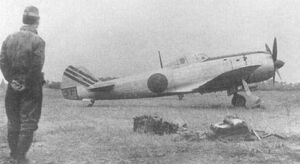In Biggles Makes Ends Meet Bertie encounters a Nakajima fighter guarding the island base of the smuggling gang. Johns was not specific about the aircraft type. There are several possible candidates but of these, the most probable is that of the Nakajima Ki-43 Hayabusa.
The Hayabusa (which means Peregrine Falcon in Japanese) was also code-named "Oscar" by the Allied Forces and unofficially called "the Army Zero" by Allied pilots as it resembled the its more famous naval cousin. Unlike the Zero which was strictly used by the Japanese Navy, the Hayabusa was used exclusively by the Japanese Army. The Hayabusa entered service in late 1941 and steadily replaced its predecessor the Nakajima Ki-27 Nate. The Hayabusa was produced in larger numbers than any other Japanese Army fighter, more than 5900 being built, and served on all major fronts including the Burma front which covered the Nicobar Islands.
The Hayabusa was well liked by Japanese pilots because of its excellent manoeuvrability but was lightly armed and armoured. Many Japanese Army aces scored most of their kills on the Hayabusa and some continued flying the type even after newer types arrived. Towards the end of the Second World War, the Hayabusa units received the newer and more heavily armed Ki-84 Hayate (codenamed "Frank") but some units operated the Hayabusa until the end of the war.
There is historical evidence for Ki-43s operating over the Nicobars. On 19 October 1944, the 1st Reserve Flying Unit is reported to have intercepted a Royal Navy carrier aircraft raid on the Nicobars with nine Ki-43-IIs. Three others were used on a suicide attack on the Royal Navy ships.[1] A Sergeant Tsuguo Shimada is also recorded as having lost his life over the Nicobars while flying with the 33rd Sentai which operated the Ki-43.[2][3]
One explanation given in Biggles Makes Ends Meet about the presence of the Nakajima was that it was an unserviceable aircraft which was abandoned when the Japanese forces retreated or surrendered and this was subsequently repaired by the smuggling gang. If this is the case, it is plausible that as the Japanese forces retreated, they would have moved their newer Hayate fighters first, leaving behind their older Hayabusas.

Another possible candidate for the aircraft Bertie saw is the Ki-84 Hayate, codenamed "Frank". It looks very similar to the Hayabusa but was more heavily armed and armoured.
The Nakajima and Biggles[]
The Nakajima is first encountered by Bertie was he follows the Colonel's Dakota to his secret island base. Approaching the island, the Japanese fighter shows up and more or less "shepherds" Bertie into a landing on the base. The Nakajima is later destroyed when Mitsubu crashes his Dakota into it after an ill-advised downwind landing. He had tried to leave the island with the Count with a storm approaching, but not being able to outrun the weather, decided to return to base, not knowing that the wind had shifted.
Specifications[]
- Crew: One
- Length: 8.92 m (29 ft 3⅜ in)
- Wingspan: 10.84 m (35 ft 6¾ in)
- Empty weight: 1,910 kg (4,211 lb)
- Loaded weight: 2,590 kg (5,710 lb)
- Max. takeoff weight: 2,925 kg (6,450 lb)
- Engine: 1 × Nakajima Ha-115 fourteen cylinder air-cooled radial engine, 1,150 hp
- Maximum speed: 530 km/h (286 knots, 329 mph) at 4,000 m (13,125 ft)
- Cruise speed: 440 km/h (237 knots, 273 mph)
- Range: 1,760 km (952 nmi, 1095 mi)
- Ferry range: 3,200 km (1,730 nmi, 1,990 mi)
Service ceiling: 11,200 m (36,750 ft)
Armament[]
- Guns: 2× fixed, forward-firing 12.7 mm (.50 in) Ho-103 machine guns in the nose
- Bombs: 2× 250 kg (551 lb) bombs
